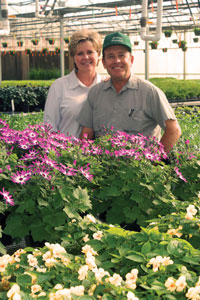2/21/2011
Good Attitude in High Altitude
Pam Buddy-D’Ambrosio

What started as a hobby in 1984 now has become at times a 48-hour workday for Jack Manning of Manning’s Greenhouse in Kirtland, New Mexico. Jack and his father (named Vernon, but also called Jack), built the original greenhouse to grow petunias, marigolds, tomatoes and peppers for their own yards and kitchens. The following year they increased the size of the greenhouse, grew plants for themselves, plus threw in some extras of which they sold every one. In August 1986, they added three Quonset hoops and officially opened the greenhouse for retail sales.
In 25 years, Jack, his wife Michelle, and Jack’s father have expanded the business to 125,000 sq. ft. of covered growing space as well as 9,000 sq. ft. outdoors. The acreage allows for a wholesale/retail nursery and garden center that serves the climate-diverse customers in the Four Corners.
Zone coverage
Kirtland is situated in the northwest corner of New Mexico at an altitude of about 5,200 ft. With 90 wholesale customers spread throughout various elevations in New Mexico, northeastern Arizona and southwestern Colorado, Manning’s Greenhouse services eight hardiness zones—3 to 10.
The health of the plants is the main concern when shipping them through fluctuating temperatures. Jack says up until May the temps can be near freezing when the drivers leave in the morning. Their gooseneck trailers are enclosed with foam insulation for frost protection. In January, they begin the shipments of tomatoes, peas and carrots to Phoenix and continue deliveries until May. There are no shipments to Phoenix in the summer when only vinca grows there. They return to Phoenix in the fall with what are known in the north as spring plants, such as petunias. Jack says Phoenix likes geraniums—in the amount of 25,000 4.5-in. pots and 70,000 1-gal. containers. In May, plants get delivered up to 8,400 ft. in chilly Eagle Nest, New Mexico, in Zone 3; and in mid-September the plants head south to Las Cruces, New Mexico, and El Paso, Texas, in Zone 8.
To coordinate the varied planting times and delivery schedules, Jack uses a Starcom forecasting computer system. It includes a library and a production catalog, and allows the user to plug in information that is translated into the length of time to grow the plants in plug trays and 6-packs, when to seed and when to pot. A sales section of the program lists every item with a bar code and generates invoices. After a season has ended, Jack can produce reports of the number of plastic trays and baskets used, which helps in forecasting for the next season. It beats doing the spreadsheets by hand as in the 1980s, when Jack calculated every week when to seed and when to transplant.
Plants and perseverance
The chile is king in New Mexico. There’s even a Chile Pepper Institute, a New Mexico Chile Association and a New Mexico Chile Pepper Task Force organized to maintain the profitability of chilies in New Mexico. Jack grows 30 varieties of chilies—mild to extra hot—including the New Mexico long green chile, bell pepper, jalapeno and Serrano. Jack grows standard bedding plants and veggies from A to Z, as well as perennials and herbs; hanging baskets are also popular items. Jack finds that in their 100 ft. x 30 ft. retail space, the ladies head for the flowers, while the guys head to the veggies or just hang out.
There are two garden centers in a nearby town, but they don’t pose a problem for Jack as he supplies both of them. He says, “We don’t try to undersell them; our retail is equal to or higher than that of our customers’.” In Manning’s Greenhouse advertisements, both garden centers are mentioned as alternate destinations. “We’re on good terms,” says Jack.
Jack says that he has attended the School of Hard Knocks, which has given him plenty of learning experiences and room to make mistakes.
“Just when you have it figured out, Mother Nature throws you a curve ball,” he says. On a recent trip to Disneyland with his kids and grandkids, the temperatures in New Mexico reached -8F. The heaters kept up, but when the thermometer read -12F, Jack received a frantic call from work—one of the heaters went out in a greenhouse. Jack had the staff move everything out of that greenhouse and into another one. Over half of the tomato crop was lost, but the vacation was saved.
Jack’s tips for success
- Most people are worried about the pricing. Don’t be afraid to charge what you need to make a profit.
- Don’t be afraid to show customers what the product looks like. For example, show them a small or an overgrown plant, advise them, and let them decide if they want it. Be straight with your customers so they know what they’re getting. GT
Pam Buddy-D’Ambrosio is a freelance writer in New Rochelle, New York.